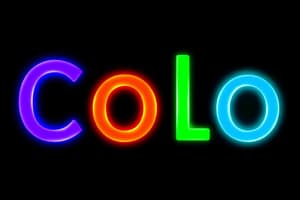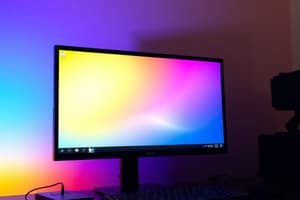Podcast
Questions and Answers
In the RGB color model, what condition defines grayscale colors?
In the RGB color model, what condition defines grayscale colors?
- R + G + B = 1
- R = G = B (correct)
- R > G > B
- R = 1, G = 0, B = 0
Which color space is specifically designed such that small numerical changes in its components correspond to similar changes in perceived color?
Which color space is specifically designed such that small numerical changes in its components correspond to similar changes in perceived color?
- L*a*b* (correct)
- HSV
- YCbCr
- RGB
What are the three components of the YCbCr color space?
What are the three components of the YCbCr color space?
- Luminance, Chroma Blue, Chroma Red (correct)
- Lightness, Green-Red, Blue-Yellow
- Red, Green, Blue
- Hue, Saturation, Value
Which of the following best describes the 'Value' component in the HSV color model?
Which of the following best describes the 'Value' component in the HSV color model?
Which color model is most suitable for image compression and video broadcasting due to its computational efficiency?
Which color model is most suitable for image compression and video broadcasting due to its computational efficiency?
What do the 'a' and 'b' components represent in the Lab* color space?
What do the 'a' and 'b' components represent in the Lab* color space?
Which color model directly represents hue and saturation as separate components?
Which color model directly represents hue and saturation as separate components?
If you have an image represented in RGB and want to modify its hue and saturation, which function in MATLAB would be most appropriate to use as a first step?
If you have an image represented in RGB and want to modify its hue and saturation, which function in MATLAB would be most appropriate to use as a first step?
In the HSV color model, what does the saturation component represent?
In the HSV color model, what does the saturation component represent?
Which color space is often preferred when performing color correction tasks that require perceptually uniform adjustments?
Which color space is often preferred when performing color correction tasks that require perceptually uniform adjustments?
Flashcards
RGB
RGB
Represents colors using Red, Green, and Blue channels.
Grays in RGB
Grays in RGB
Grayscale colors in RGB where R=G=B.
HSV
HSV
A color model with Hue, Saturation, and Value.
Hue
Hue
Signup and view all the flashcards
Saturation
Saturation
Signup and view all the flashcards
Value
Value
Signup and view all the flashcards
YCbCr
YCbCr
Signup and view all the flashcards
Luminance (Y)
Luminance (Y)
Signup and view all the flashcards
Lab*
Lab*
Signup and view all the flashcards
Lightness (L)
Lightness (L)
Signup and view all the flashcards
Study Notes
- RGB (Red, Green, Blue) represents colors through three channels.
- It can be visualized as an RGB Cube, with each axis ranging from 0 to 1.
- Example: (0, 1, 0) signifies pure green.
- It is easy for devices like monitors and cameras to process and display.
- A disadvantage is that it is not perceptually intuitive for humans.
- Grayscale colors are located along the diagonal of the RGB cube where R=G=B.
- Hue and saturation are not directly represented in RGB.
HSV
- HSV decouples the three components of color.
- Hue: the color type, is related to the angle around the vertical axis.
- Saturation: the color purity, is the distance from the vertical axis.
- Value: the brightness, is the height on the vertical axis.
- It's visualized as an RGB cube tilted on its vertex, creating a cylindrical form.
- Use rgb2hsv() and hsv2rgb() in MATLAB for conversions between RGB and HSV
YCbCr
- YCbCr separates an image into three components:
- Y (Luminance): image brightness.
- Cb (Chroma Blue): the blue color component.
- Cr (Chroma Red): the red color component.
- It is fast to compute and efficient for compression.
- It sees wide use in TV broadcasting and video processing.
Lab*
- Lab* is a perceptually uniform color space that approximates human vision.
- L (Lightness): represents color brightness.
- a: green-red axis, ranges from green (-a) to red (+a).
- b: blue-yellow axis, ranges from blue (-b) to yellow (+b).
- Small value changes correspond to similar perceived color changes.
- It is ideal for color correction and accurate comparisons.
Studying That Suits You
Use AI to generate personalized quizzes and flashcards to suit your learning preferences.



